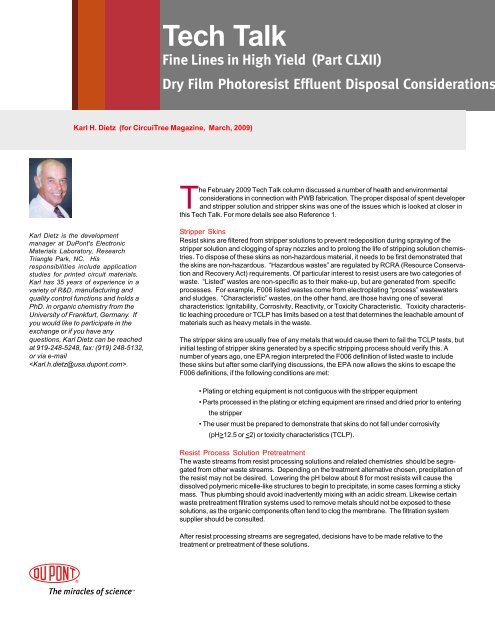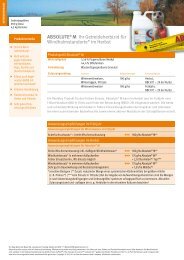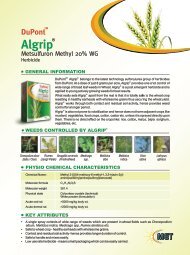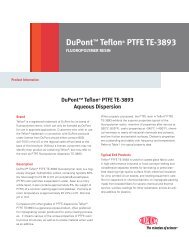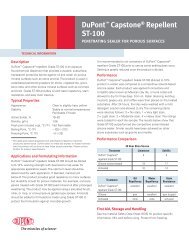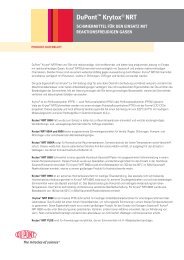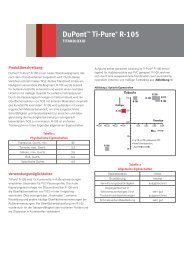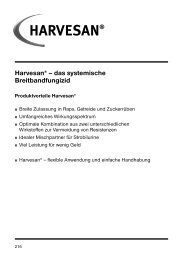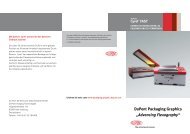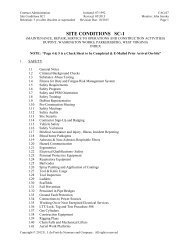Tech Talk Fine Lines in High Yield (Part CLXII) Dry Film ... - DuPont
Tech Talk Fine Lines in High Yield (Part CLXII) Dry Film ... - DuPont
Tech Talk Fine Lines in High Yield (Part CLXII) Dry Film ... - DuPont
Create successful ePaper yourself
Turn your PDF publications into a flip-book with our unique Google optimized e-Paper software.
<strong>Tech</strong> <strong>Talk</strong><br />
<strong>F<strong>in</strong>e</strong> <strong>L<strong>in</strong>es</strong> <strong>in</strong> <strong>High</strong> <strong>Yield</strong> (<strong>Part</strong> <strong>CLXII</strong>)<br />
<strong>Dry</strong> <strong>Film</strong> Photoresist Effluent Disposal Considerations<br />
Karl H. Dietz (for CircuiTree Magaz<strong>in</strong>e, March, 2009)<br />
Karl Dietz is the development<br />
manager at <strong>DuPont</strong>'s Electronic<br />
Materials Laboratory, Research<br />
Triangle Park, NC. His<br />
responsibilities <strong>in</strong>clude application<br />
studies for pr<strong>in</strong>ted circuit materials.<br />
Karl has 35 years of experience <strong>in</strong> a<br />
variety of R&D, manufactur<strong>in</strong>g and<br />
quality control functions and holds a<br />
PhD. <strong>in</strong> organic chemistry from the<br />
University of Frankfurt, Germany. If<br />
you would like to participate <strong>in</strong> the<br />
exchange or if you have any<br />
questions, Karl Dietz can be reached<br />
at 919-248-5248, fax: (919) 248-5132,<br />
or via e-mail<br />
.<br />
The February 2009 <strong>Tech</strong> <strong>Talk</strong> column discussed a number of health and environmental<br />
considerations <strong>in</strong> connection with PWB fabrication. The proper disposal of spent developer<br />
and stripper solution and stripper sk<strong>in</strong>s was one of the issues which is looked at closer <strong>in</strong><br />
this <strong>Tech</strong> <strong>Talk</strong>. For more details see also Reference 1.<br />
Stripper Sk<strong>in</strong>s<br />
Resist sk<strong>in</strong>s are filtered from stripper solutions to prevent redeposition dur<strong>in</strong>g spray<strong>in</strong>g of the<br />
stripper solution and clogg<strong>in</strong>g of spray nozzles and to prolong the life of stripp<strong>in</strong>g solution chemistries.<br />
To dispose of these sk<strong>in</strong>s as non-hazardous material, it needs to be first demonstrated that<br />
the sk<strong>in</strong>s are non-hazardous. “Hazardous wastes” are regulated by RCRA (Resource Conservation<br />
and Recovery Act) requirements. Of particular <strong>in</strong>terest to resist users are two categories of<br />
waste. “Listed” wastes are non-specific as to their make-up, but are generated from specific<br />
processes. For example, F006 listed wastes come from electroplat<strong>in</strong>g “process” wastewaters<br />
and sludges. “Characteristic” wastes, on the other hand, are those hav<strong>in</strong>g one of several<br />
characteristics: Ignitability, Corrosivity, Reactivity, or Toxicity Characteristic. Toxicity characteristic<br />
leach<strong>in</strong>g procedure or TCLP has limits based on a test that determ<strong>in</strong>es the leachable amount of<br />
materials such as heavy metals <strong>in</strong> the waste.<br />
The stripper sk<strong>in</strong>s are usually free of any metals that would cause them to fail the TCLP tests, but<br />
<strong>in</strong>itial test<strong>in</strong>g of stripper sk<strong>in</strong>s generated by a specific stripp<strong>in</strong>g process should verify this. A<br />
number of years ago, one EPA region <strong>in</strong>terpreted the F006 def<strong>in</strong>ition of listed waste to <strong>in</strong>clude<br />
these sk<strong>in</strong>s but after some clarify<strong>in</strong>g discussions, the EPA now allows the sk<strong>in</strong>s to escape the<br />
F006 def<strong>in</strong>itions, if the follow<strong>in</strong>g conditions are met:<br />
• Plat<strong>in</strong>g or etch<strong>in</strong>g equipment is not contiguous with the stripper equipment<br />
• <strong>Part</strong>s processed <strong>in</strong> the plat<strong>in</strong>g or etch<strong>in</strong>g equipment are r<strong>in</strong>sed and dried prior to enter<strong>in</strong>g<br />
the stripper<br />
• The user must be prepared to demonstrate that sk<strong>in</strong>s do not fall under corrosivity<br />
(pH>12.5 or
Developer Solution<br />
Table 1 shows the characteristics of typical spent aqueous developer solutions us<strong>in</strong>g the recommended<br />
developer chemistry. For aqueous developers, the copper concentration is generally low<br />
enough, that the developer solution can be metered <strong>in</strong>to the f<strong>in</strong>al neutralization section beyond the<br />
plant’s waste pretreatment system or neutralized separately and metered <strong>in</strong>to the sewered<br />
streams. These solutions should be analyzed <strong>in</strong>itially and if possible before each dump to <strong>in</strong>sure<br />
that no metals have been dragged <strong>in</strong>. Care must be exercised <strong>in</strong> the rate of meter<strong>in</strong>g and the pH<br />
control of this step, s<strong>in</strong>ce dropp<strong>in</strong>g the pH below 8, may result <strong>in</strong> some precipitation of the dissolved<br />
resist materials.<br />
Table 1 - Characterization of Typical Developer Solution - Loaded<br />
Resist COD BOD TOC Load<strong>in</strong>g* Copper**<br />
Aqueous 15-22,000 2,500-3,600 2,000-2,800 12-13 msf/gal
In this case cost of treat<strong>in</strong>g the metals must be considered versus the cost of the stripper<br />
solution, if feed-and-bleed is used. Us<strong>in</strong>g straight caustic solution will not complex the copper<br />
and have lower copper concentrations, but may attack solder plat<strong>in</strong>g more rapidly.<br />
Proprietary strippers conta<strong>in</strong><strong>in</strong>g metal complexers may be used <strong>in</strong> circumstances where solder<br />
plat<strong>in</strong>g must be protected from caustic strippers, more rapid stripp<strong>in</strong>g is desired, or a sh<strong>in</strong>y copper<br />
surface is desired. Copper concentrations for these strippers will be much higher (see Table 4):<br />
Table 4 - Typical Metals (Concentrations)<br />
Found <strong>in</strong> Spent (Proprietary) Strippers (Ref. 2)<br />
Metal Concentration (ppm)<br />
Copper 30-300<br />
Lead 50-150<br />
Nickel 5-10<br />
T<strong>in</strong> 5-20<br />
Chromium 3-10<br />
Where the organic and/or metal concentrations are too high for discharge, there are two choices.<br />
The solution can be pretreated <strong>in</strong> a batch treatment to reduce the organic strength (see conditions<br />
<strong>in</strong> Table 5) and then to precipitate the metals as <strong>in</strong>soluble complexes. Two metal-complex<strong>in</strong>g<br />
materials often used to precipitate the metals (copper and lead) from process solutions are DTC<br />
(dithiocarbamate) and TMT-15 (trisodium trimercapto-s-triaz<strong>in</strong>e) The alternative to batch treatment<br />
for the removal of organics and metals is to have the solutions hauled away for <strong>in</strong>c<strong>in</strong>eration.<br />
Load<strong>in</strong>g <strong>in</strong> Procedure<br />
Table 5 - Typical (Aqueous, Caustic) Stripper;<br />
Precipitation of Organics- Chemistry & Results<br />
Filter<br />
COD mg/l<br />
msf/gal<br />
rate<br />
(after)<br />
18-19 H2SO4 to pH 4 or 5 1-18 2000-4300<br />
Filter rate is <strong>in</strong> gallons per m<strong>in</strong>ute per square foot of filter us<strong>in</strong>g a 1-2 micron filter, usually us<strong>in</strong>g a<br />
filter aid.<br />
The particular chemicals, order and manner of their addition depend on the resists that are<br />
present <strong>in</strong> the stream. Care should be taken to ma<strong>in</strong>ta<strong>in</strong> effective stirr<strong>in</strong>g and use slow addition of<br />
dilute precipitat<strong>in</strong>g materials. This will m<strong>in</strong>imize the tendency of resist precipitates to form a<br />
gelat<strong>in</strong>ous material. Proprietary resist treatment chemicals are be<strong>in</strong>g offered for the neutralization,<br />
precipitation, flocculation, and de-tackification of resist from spent stripper solutions, to form a<br />
readily filterable precipitate.<br />
References<br />
1. Cost Effective and Environmentally Responsible Management of <strong>Dry</strong> <strong>Film</strong> Resist Process<br />
Waste Streams, John W. Lott & Karl H. Dietz, North East Circuits Association, <strong>Tech</strong>Con ’95,<br />
November 8-9, 1995, Chelmsford, MA<br />
2. “<strong>Dry</strong> <strong>Film</strong> Stripper Additives: Impact on the Stripper Disposal Process”, John A. MacNeill,<br />
CircuiTree, November 1994, pg.62


